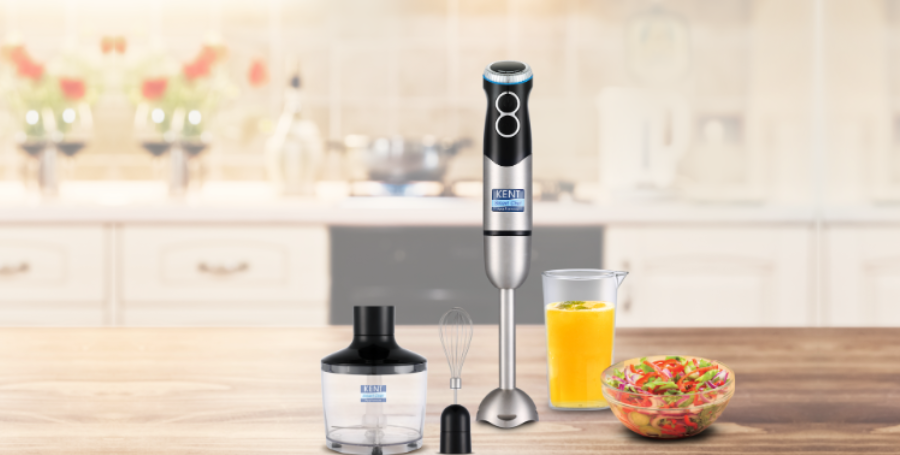2Views 0Comments

Hand Blender vs Hand Mixer: Choosing the Right Kitchen Appliances
Modern kitchens are built around convenience and efficiency. Compact and easy-to-use tools make cooking simpler and faster. Among these, the hand blender and the hand mixer are two essential appliances that often look similar but serve different purposes. Understanding how each one functions helps you choose the right tool for your kitchen.
Understanding a Hand Blender
A Hand Blender, also known as an immersion blender, blends ingredients directly in a pot or bowl. You can use it for:
- Making smoothies and soups
- Blending sauces and gravies
- Preparing baby food or purees
Most models have detachable blades and speed controls for convenience. Lightweight, compact, and easy to clean, it’s a handy tool for quick, everyday cooking tasks.
What is a Hand Mixer?
A hand mixer helps mix, whisk, and whip ingredients evenly. It uses rotating beaters to blend smoothly, making it ideal for baking and desserts. Most models have speed controls and detachable beaters or dough hooks for easy handling. You can use it for the following.
- Whipping cream or beating eggs
- Mixing cake or cookie batter
- Preparing frosting or light dough
Compact and efficient, it gives smooth, fluffy textures and helps you prepare recipes with less effort.
Key Differences Between a Hand Blender and a Hand Mixer
Both the blender and the hand mixer are useful in the kitchen, but their roles differ. The table below highlights the key distinctions:
| Feature | Hand Blender | Hand Mixer |
|---|---|---|
| Purpose | Blends and purees liquids | Mixes and whips ingredients |
| Best For | Soups, smoothies, sauces | Cakes, creams, and dough |
| Attachments | Blades, whisk, chopper | Beaters, dough hooks |
| Cleaning | Easy with detachable parts | Requires cleaning of beaters |
| Storage | Compact and convenient | Slightly larger but portable |
Both appliances perform efficiently within their intended use. Choosing between them depends entirely on your cooking style and needs.
When to Use a Hand Blender?
The blender is ideal for blending liquids and soft foods quickly and smoothly. It helps prepare meals directly in the cooking container, saving time and effort. Best uses of a hand blender:
- Blending soups and curries into a smooth texture
- Making fruit smoothies or shakes
- Preparing sauces, dips, or dressings
Since it is compact, easy to handle, and simple to maintain, the hand blender is a practical addition to any modern kitchen.
When to Use a Hand Mixer?
A hand mixer is best suited for tasks that involve whipping, mixing, or beating ingredients. It adds air to mixtures, creating light and fluffy results in baking and dessert preparations. Best uses of a hand mixer are mentioned below.
- Beating eggs or whipping cream
- Mixing batter for cakes, pancakes, or muffins
- Preparing frosting, dough, or cookie mixtures
The hand mixer offers control and consistency, ensuring even results every time. It is a reliable tool for anyone who enjoys baking or making desserts at home.
Where a Wet Grinder Fits In
The Wet Grinder is another essential appliance commonly used in Indian kitchens. It grinds soaked grains and pulses into a fine paste, which is ideal for traditional dishes like dosa, idli, and vada. The grinder uses stone rollers that preserve nutrients and texture, ensuring authentic results every time.
Each of these appliances, the hand blender, hand mixer, and wet grinder, serves a unique purpose. Together, they help create a well-rounded kitchen setup that supports both modern and traditional cooking styles.
Tips for Buying the Right Kitchen Appliance
Keep a few key things in mind to make sure it works well and lasts long when buying a kitchen appliance. Here are some useful tips to help you choose the right one.
- Motor Power: Choose a higher wattage for heavier tasks.
- Speed Control: Look for adjustable speed settings for better results.
- Attachments: Detachable parts make cleaning easier.
- Material Quality: Stainless steel components last longer.
- Design: Ergonomic handles improve comfort and grip.
By focusing on these factors, you can select an appliance that fits your cooking style and makes food preparation more enjoyable.
Conclusion
Each appliance brings its own strengths to the kitchen. One simplifies blending and pureeing, another ensures perfect consistency for batters and whipped mixtures, and a third handles traditional grinding tasks with ease. Together, they create a balanced kitchen setup that supports convenience, versatility, and efficiency in everyday cooking.


